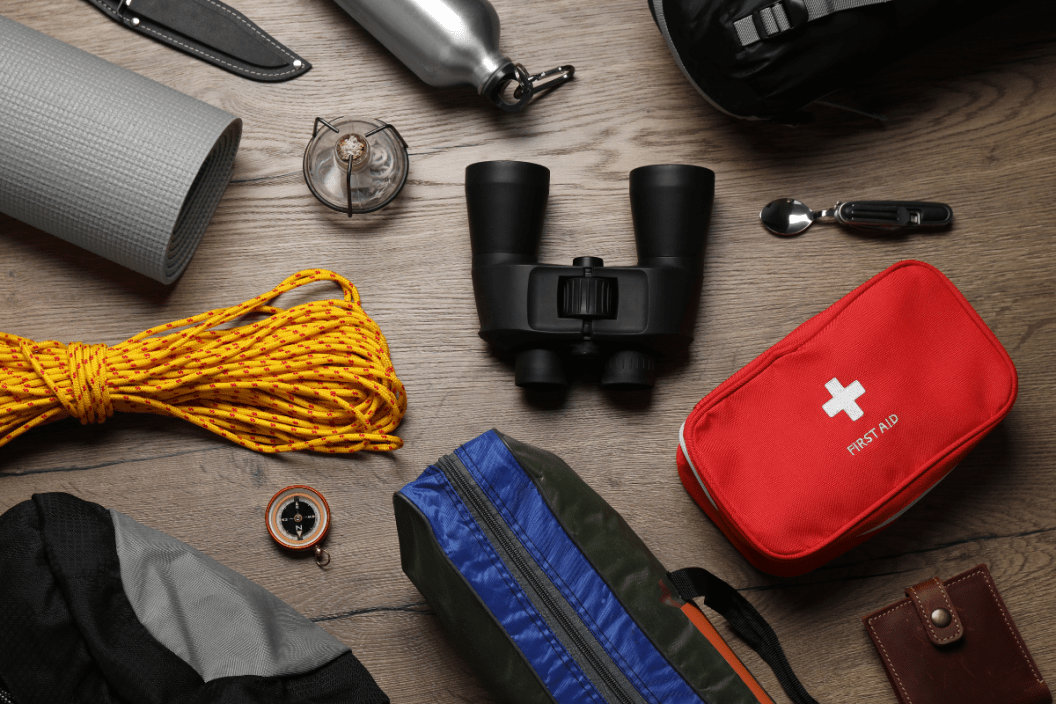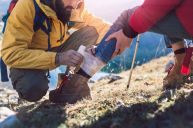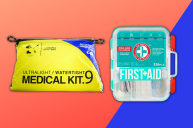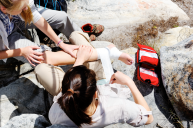Not everyone is a trained EMT who's ready to practice wilderness medicine on their next camping trip. Since the Red Cross is busy helping people with serious needs, it's better that campers come prepared with their own first aid kits to deal with everything from minor cuts and scratches, to more serious injuries like burns and *gulp* broken bones. Below you'll find the most essential supplies to stock your own outdoor adventure medical kit with.
Best First Aid Kits for Camping
https://www.instagram.com/p/CFONJDiB0h0/
Some of the best first aid kits are sold ready-to-go through websites such as Amazon and Surviveware.com, not to mention brick and mortar stores like REI and Walmart. If you really want to go all out, consider getting a serious emergency kit that includes survival items like an emergency blanket, a whistle, and more.
What to Put in a First Aid Kit for Camping
https://www.instagram.com/p/CAwzUgGADts/
RELATED: When Does Camping Season Start Anyway?
To ensure your first aid kit is up to snuff, feel free to use this following selection of first aid only items as a sort of checklist. Please note that we're taking a bare minimum approach here, so you won't see items like CPR masks in the mix.
Sunscreen: As the legend has it, Benjamin Franklin once said, "An ounce of prevention is worth a pound of cure." When it comes to camping gear, preparedness is everything. At the end of the day, the best medical supplies are preventative in nature, and high quality sunscreen can save you a lot of trouble no matter where or when you're camping. Ditto on insect repellant... and bear spray.
Tweezers: Splinters are some of the most common assailants people face on a campout, thanks to firewood, forests, and other culprits. And don't even get us started on cactus needles! Just remember to make sure your set of stainless steel prongs is sterile before use.
Bandaids: From tiny adhesive bandages for covering blisters, to more advanced butterfly bandages, bandaids are your go-to for fast, mild and moderate wound care. Since you're heading outdoors (i.e. where all the lakes and rivers live), it's better to spend a little more money and get the water-resistant type.
Moleskin: Speaking of blisters, moleskin is one of the best ways to both treat and avoid the little buggers. These soft, sometimes adhesive cotton pads can be applied wherever blisters are or might form, offering relief from irritating contact. Hikers and backpackers will be particularly thankful they've included these tiny friends in their wilderness first aid kits.
Antiseptic: Whether you're using antiseptic wipes, hand sanitizer, or antibiotic ointments like Neosporin, having some sort of antiseptic on hand is even more important than bandages. After all, what good is wrapping up cuts, scrapes, and other wounds up if they aren't clean and you get infected?
Ibuprofen: You never know when you're going to need pain relief, and Ibuprofen is a tried and true hero when it comes to fast working anti-inflammatory action. While you might also include pain killers like acetaminophen and aspirin in your kit, make sure to consult your doctor before you settle on anything.
Antihistamine: The thing about allergic reactions is that you usually don't know you have them until the first time they happen. Sadly, these first time strikes many folks while they're enjoying the outdoors. This being the case, its a good idea to have antihistamines in your kit to help you deal with both mild and serious reactions. As ever, please consult a physician to see which options are best for you.
Hydrocortisone: Similar to antihistamines, hydrocortisone is a steroid that can help relieve itching, swelling, and general irritation caused by everything from bug bites and sunburn to encounters with poison oak, ivy, and sumac. While weaker formulas can be bought over the counter, note that you'll have to get a prescription for a more serious cream. Quick medical training tip: don't apply hydrocortisone on open wounds and sores.
Larger Wound Treatment: When bandaids aren't enough, it's good to have a more comprehensive wound treatment system at the ready. In order to deal with the sort of injuries we hope you never have to face in the wild (or at all for that matter), it's better to include gauze pads and medical tape in your kit. When it comes to cleaning nasty cuts and abrasions, you might also be happy you packed cotton swabs and an irrigation syringe. Similarly, shears should make your cut as well... Get it?
Safety Pins: The original multi-tool, safety pins have a number of handy applications. Gotta pop a blister? Safety pin. Need to tighten that tourniquet? Safety pin. Whether you're dealing with an existing injury or making sure to avoid one by pinning up things like torn shoe laces and ripped clothing, safety pins of various sizes are there to the rescue!
Duct Tape: You know what they say! If you can't duct it... Sorry, we forget how the rest of the rhyme goes. The best first aid and survival kits should always include duct tape, because you just never know when it might come in handy. Like safety pins, duct tape has a range of applications, from tearing out the sort of tiny needles cactuses and nettle leave on your limbs, to holding a splint in place, if you've got room in your kit, add this silver beauty to your collection.
Sam Splint: Even if you're backpacking and can only maintain a small first aid kit to deal with medical emergencies, you should definitely consider packing a Sam Splint. In addition to being ultralight, these specialized tools are malleable and go a long way when treating sprains, or worse, broken bones. Car campers and backcountry trekkers alike can benefit from these sophisticated first aid supplies.
What else would you add to a camping first aid kit? Save someone's outdoor adventure on our Wide Open Roads Facebook!




